 Background The Bytown and Prescott Railway opened the first line into Ottawa in December 1854. It passed through Kemptville. It wasn’t until thirty years later that another railway was built through this area when the Canadian Pacific Railway, masquerading as the Ontario and Quebec, built its main line, now the Winchester subdivision, between Smiths Falls and Montreal. The CPR had to cross the Bytown and Prescott, by then the St. Lawrence and Ottawa, just south of Kemptville. This is the story of the crossing of the two lines. Early
protection
By 1912 the junction was known as Kempton. An
interlocking is installed With rail traffic increasing heavily the Board of Railway Commissioners became concerned about the safety of non interlocked crossings such as this one. Should a train miss a warning signal the possibility of a serious accident was very real. There was thus a general move to provide full interlockings at such locations. Plans for an interlocking machine at Kempton Junction were approved in February 1919.[4] This 40 lever machine [5], with 34 working levers and 6 spare, was inspected by Mr. A.A. Belanger, Assistant Engineer of the Board on 9 June. At that time, railway companies could use such new installations before a Board inspection, but only by bringing each train to a complete stop and flagging it over the crossing. Following the inspection, an order was issued on 12 June 1919 [6], which authorized the railway to operate its trains through the interlocking without first bringing them to a stop. The interlocking was a much safer form of train control because the junction was fully signalled and interlocked and derails were provided. Warning of the approach of trains was given by annunciator bells. The switches and derails were operated by cranks and bolted by their respective traffic levers which formed approach and route locking. The machine was housed in a purpose built tower (18 feet by 29 feet 2 inches). Although shown as Kempton in correspondence with the Board at that time, instructions to train crews issued in May 1919 [7] refer to Bedell Crossing.
Removal
of the derails In February 1932 the railway applied for permission to remove the derails and the Chief Operating Officer of the Board, Mr. G. Spencer inspected the plant on 17 February. He found the plant to be efficient and well maintained but went on to say: “A southbound
passenger train
stopped with the engine and baggage car on the crossing and the
northbound way
freight came in and after switching and getting its train together
stopped on
the crossing to allow a small quantity of way freight to be unloaded
into the
freight shed which is just north of the crossing. Both
these operations would be exposed to a
train on the main line which might fail to stop at the home signals
respectively east and west of the crossing, the stopping point for
which, at
the present time, is just short of the derails presently located in the
tracks;
and under the proposal, it would be the home signals 50' to 60' east
and west
respectively of the derails in the track. “The derail
in the Prescott
line south of the crossing is 166' away from the crossing, placed there
in
order to shorten up the distance that passengers transferring to or
from the
main line trains are required to walk, as against the standard location
of 500'
usually provided. The location of this
particular derail was agreed upon when the plant was interlocked some
years
ago, when the train on which I travelled
to Bedell, after it had detrained its passengers, when the stop was
first made,
as described above, moved south until its rear end cleared the derail,
otherwise the route could not have been given to the westbound fast
mail, with
which connection was made, and is made every day. “I am against
the removal of
derails . Should the decision be to
approve the company's application, I would suggest that the south
distant
signal on the Prescott line be made operative instead of fixed as at
present
and the home signal south of the crossing be put out to a distance of
500' from
the crossing of the eastbound main line.” Although the railway complained at the expense of maintaining derails they were denied permission to remove them [8]. However, the railway was very tenacious and on 25 October 1937 wrote a further letter to the Board: “In 1932 we
applied to remove
the derails at Bedell. At that time we
were unable to say just what saving we would effect by the removal of
the
derails. Since that time we have kept a
record and it has been found that three additional sectionmen are
required
during four months of each year at a monthly rate of $85.00 each which
amounts
to $1,020 per year for labour to remove snow from the derails and pick
ice and
snow from between the main line rails from the derails to the diamond,
which
cannot be removed with flanger or snow plow on account of the guard
rails. “In order to effect the above mentioned saving and also to eliminate the hazard created by the derails I beg to renew our application for permission to remove the derails at this point.” Note that the railway referred to derails as a hazard! Permission was granted on 4 November 1937 [9]with the proviso that the speed of trains operated over the diamond on the Prescott subdivision should not exceed 20 mph. The railway, maybe concerned that the Board would change its mind, completed the changes on 23 November! The plan shows the same 40 lever machine with 30 working levers, 6 spare levers and 4 spare spaces. Increasing
train speeds In 1941, the railway requested authority to run its passenger trains on the Winchester subdivision at 50 mph over the crossing. The Board Signal Engineer, D.M. Neill, reported on 30 July: “The
interlocker involved is
a full electro mechanical plant with electrical home and distant
signals with
track circuits and detector locking on the Winchester sub. and
electrical home
and distant signals with track circuits and detector locking on the
Prescott
subdivision in one direction and electrical home and fixed distant
signals in
the other direction without track circuits. “With a spacing of 8,900 feet and 3,170 feet for the distant signals on the Winchester sub. together with track circuit and detector locking , I see no reason why it will not be safe to operate passenger trains from a signalling point over this interlocker on the Winchester sub. at 50 mph with safety as, with the above distances, there is ample time for a train travelling at 50 mph when passing a distant signal to stop before reaching its respective home signal.” The Board approved the increase in speed in August 1941 [10]. In December 1957 Canadian Pacific wished to increase the speed of Winchester subdivision freight trains across the diamond to 50 mph. from 35 mph. A Board Inspector found that each rail was anchored in the direction of traffic on nearly every tie ¾ mile each side of diamond on the Winchester subdivision and was heavily rail anchored to about the home signal on the Prescott subdivision. About three feet of slag ballast had been placed under the diamond. Two ties, about ten feet long and bolted together, had been placed under the rail in line with the Winchester subdivision which should make it better for tamping under diamond. The diamond was in good condition and all bolts appeared to be tight. New double shoulder tie plates and pads would replace heavy sheet steel under manganese corners when they were received. At that time, traffic on the Winchester subdivision had about 6 passenger trains and 15-24 freight trains per day. Bedell station, 300 feet east of the diamond, was the first open telegraph station east of Smiths Falls during night. Many trains stopped for orders or slowed down for clearances so not all of the freight trains would be running at high speed over the diamond. The improvements made to the diamond crossing were such that freight trains could use it safely at higher speeds and authority to run all trains on the Winchester subdivision at 50 mph. was given in January 1958 [11]. Trains on the Prescott subdivision continued to be restricted to 20 mph. over the diamond. Removal
of the diamond There were some detailed technical alterations. The signal 5,460 feet north of the junction switch was changed from inoperative to an interlocked signal with a yellow or red indication only. Also yard limits were extended from 1 mile north of Bedell to mile 28.9, Kemptville, to enable the switcher from Smiths Falls to work at Kemptville. The diamond was removed on 2 Oct 1967 and the signal changes were completed on 12 Oct 1967 [13]. Conversion
to Automatic Block Signalling The changes made in 1967 reduced the duties of the operators to lining the switches for infrequent movements on to the Prescott subdivision on which traffic became very light. By 1969, this was usually one movement a day and it was decided to convert the switches to hand throw worked by train crews and to eliminate the operators. Of course, the CPR needed permission from the regulator, now the Canadian Transport Commission. The CPR wrote to the CTC on 25 June 1970 requesting authority to convert to Automatic Block Signalling and to change the switches to hand throw operated by train crews who would request permission from the dispatcher before entering the main line. Block indicators would be installed and minor changes made to the signal aspects to comply with ABS rules. On June 25 1970 a signal inspector and the district operations inspector made a joint inspection of the plant to see whether the changes could be made. To their consternation, they found that the changes had already been made on 31 October 1969. Their joint report to the Directors of Engineering and Operations makes much of the need for the railway to request permission before making such changes and adds, almost as an afterthought, that the system was functioning as intended at the time of the visit and the system was operationally sound. A stern letter was sent from the Secretary of the CTC on 24 July 1970 to which the railway replied on 25 August. The railway, rather lamely, claimed to have mislaid the plans and regretted that the application was not made to the CTC at the proper time. Nobody seems to have picked up on the fact that the changes were made only 9 days after the date of the plan so it is unlikely that permission could have been obtained in that short time. The CTC took its time in issuing the order authorizing the changes. This did not come until 2 November 1970 [14] and CPR thus had operated it, technically, illegally for just over a year! So this completes the story of Bedell. The former Prescott subdivision is but a shade of its former self. Northbound it is known as the North Prescott spur and extends 2.4 miles to Kemptville. Southbound the South Prescott spur runs 5 miles to Oxford. The passenger trains no longer run but there is a great deal of freight activity. So next time you are railfanning in the area spare a thought for a crossing which has had a very interesting history. |
|
Lever |
June1919 |
November 1937 |
October 1967 |
|
1 |
Dwarf signal
standing to right of eastbound main track opposite
signal 104 governs trains to any available route within limits of
interlocking plant and also serves as a "Calling on arm for signal 1034
at slow speed" |
As before but
placed on bracket post 1034 |
As before |
|
2 |
Dwarf signal for eastward movements on north main,
Winchester |
Dwarf signal
1034C for eastward movements from siding to north main, Winchester,
(formerly lever 3) |
As before |
|
3 |
Dwarf signal
for eastward movements from siding to north main, Winchester |
Dwarf signal
1034B for eastward movements on north main, Winchester (formerly lever
2) |
As before |
|
4 |
Dwarf signal
(1034D) for eastward movements from eastbound siding on to south main |
As before |
As Before |
|
5 |
Home signal,
upper arm of bracket post signal 1034, governs eastbound trains to
Montreal |
As before |
As before |
|
6 |
Home signal,
lower arm of bracket post signal 1034, governs trains to signal 306 to
Ottawa |
As before |
Three arms
replaced by two arms, spare lever. |
|
7 |
Home signal
306 governs trains towards Ottawa |
Spare lever,
signal 306 removed |
Spare lever |
|
8 |
Two Hayes
derails, north sidings Winchester |
As before |
As before |
|
9 |
Switch from
north main, Winchester, to siding. |
As before |
As before |
|
10 |
Crossover
switches north to south main Win, |
South main
crossover switch Winchester |
As before |
|
11 |
Switch from
north main, Winchester, to north connecting track |
As before |
As before |
|
12 |
Derail from
north connecting to north main, Winchester |
Derail
removed, lever used for home signal 306 for movements towards Smiths
Falls |
Spare lever |
|
13 |
Derail for
eastward movements on south main Winchester across diamond |
Derail
removed, lever used for new dwarf signal on 306 |
Spare lever |
|
14 |
Traffic lever
for north main, Winchester, locks 8, 9, 10 (north), 11 and 12 |
Facing point
lock for levers 9 and 19 |
As before |
|
15 |
Traffic lever
for movements on south main, Winchester, locks 10 south and 13. |
Facing point
lock for lever 13 removed, lever used for facing point lock for lever 10 |
As before |
|
16 |
Switch and
derail from eastbound siding to south main Winchester, west of diamond |
As before |
Facing point
lock removed, lever used for switch only. |
|
17 |
Dwarf signal,
lower arm on signal 1033 governs trains over any available route and
serves also as a "Calling on arm" to main track within the limits of
the Interlocking Plant, at low speed |
As before |
Spare lever |
|
18 |
Home signal,
upper arm on signal 1033 governs trains to Westbound Main Track towards
Smiths Falls |
As before |
Spare lever |
|
19 |
Spare space |
North main
crossover switch, Winchester |
As before |
|
20 |
Spare space,
later used as facing point lock for 12 |
Facing point
lock for lever 12 removed, lever used for facing point lock for lever 11 |
As before |
|
21 |
Spare space |
Spare space |
Spare space |
|
22 |
Switch and
derail Prescott to north west connecting |
Derail
removed, lever for switch only |
Switch
removed, spare lever |
|
23 |
Traffic lever,
Prescott, and facing point lock for switch
22 |
Facing point
lock for lever 22 |
Facing point
lock removed, spare lever |
|
24 |
Dwarf signal,
lower arm on signal 307 serves as a "Calling on arm" towards Prescott
or to signal 1033 towards Smiths Falls |
As before |
Spare lever |
|
25 |
Home signal,
middle arm on signal 307 governs trains to signal 1033 towards Smiths
Falls |
As before |
Spare lever |
|
26 |
Home signal,
upper arm on signal 307 governs southbound trains towards Prescott |
As before |
Spare lever |
|
27 |
Spare space |
Spare space |
Spare space |
|
28 |
Spare space |
Spare space |
Spare space |
|
29 |
Spare space |
Spare space |
Spare space |
|
30 |
Derail for
northward movements across diamond on Prescott |
Derail
removed, spare lever. |
Spare lever |
|
31 |
Traffic lever,
Prescott for movements across diamond and facing point lock for 30 |
Facing point
lock removed for lever 30, spare lever |
Spare lever |
|
32 |
Dwarf signal,
lower arm for signal 308 serves as "Calling on arm" for trains to Ottawa |
As before |
Spare lever |
|
33 |
Home signal,
upper arm on signal 308 governs northbound trains to Ottawa |
As before |
Spare lever |
|
34 |
Derail, south
main Winchester east of diamond |
Derail
removed, spare lever |
Spare lever |
|
35 |
Traffic lever
and facing point lock for 16 and 34 |
Facing point
lock for lever 16, facing point lock for lever 34 removed |
As before |
|
36 |
Dwarf signal
1031B for westward movements over diamond south main Winchester |
As before |
As before |
|
37 |
Traffic lever
for westbound movements over diamond, north main, Winchester, locks 38 |
Facing point
lock for lever 38 removed, spare lever |
Spare lever |
|
38 |
Derail, north
main Winchester east of diamond |
Derail
removed, spare lever |
Spare lever |
|
39 |
Dwarf signal,
lower arm of signal 1031 governs trains over any available route and
also serves as a "Calling on arm' to main track within limits of
Interlocking Plant at low speed |
As before |
As before |
|
40 |
Home signal,
upper arm of signal 1031 governs westbound trains to Smiths Falls |
As before |
As before |
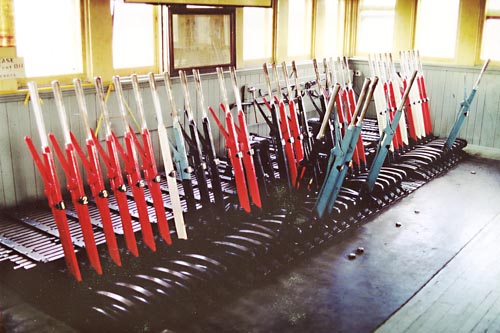 The Bedell lever frame in later years. Bruce Chapman photo. |
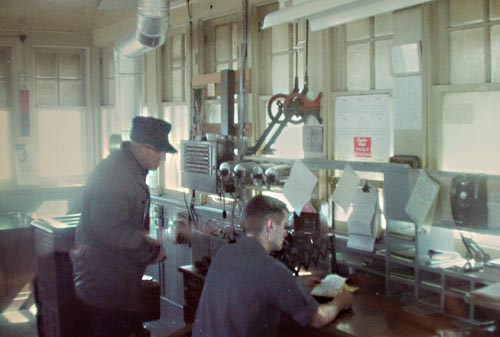 An idea of the working environment in the Bedell Tower. Bruce Chapman photo. |
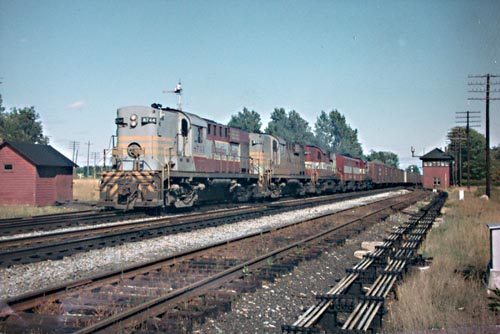 A
westbound freight train on the Winchester subdivision, with CP 8744
leading,
has just passed the tower. The
arrangement of point rodding can be seen in the foreground. The
Prescott subdivision crossed the
Winchester subdivision just this side of the tower.
|
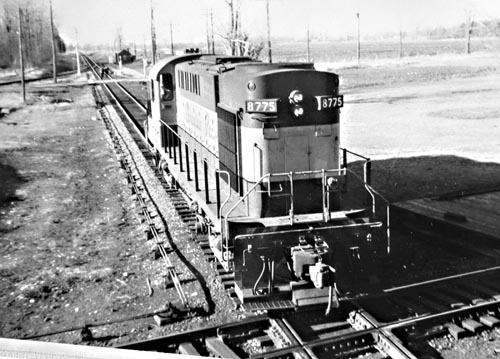 A
view taken from the tower looking north of a northbound light engine,
CP 8775,
crossing on the Prescott subdivision. The
diamond with the north Winchester subdivision track
can clearly be
seen as can the north connecting track to the Winchester subdivision.
|
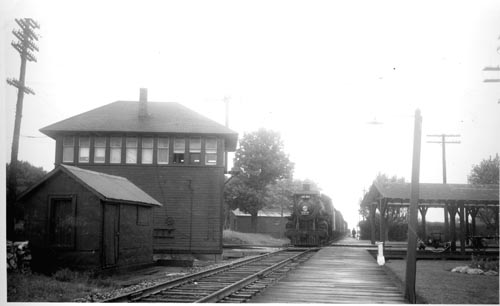 Wayfreight,
No. 94 is heading south with CP 2207 standing
just north of
the diamond in September 1948. The
station awning on the main line platform can be seen to the
right.
Canada Science and Technology Museum –
Matt-3835.
|
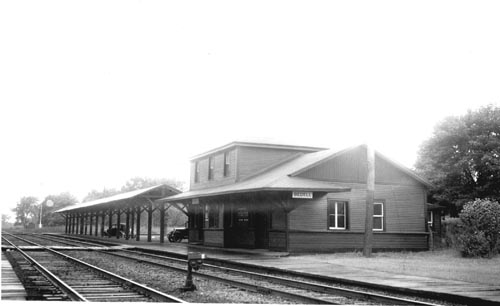 A
September 1948 view looking west showing the station and north platform
awning
with the diamond just beyond the platform. Canada
Science and Technology Museum – Matt-3836.
|
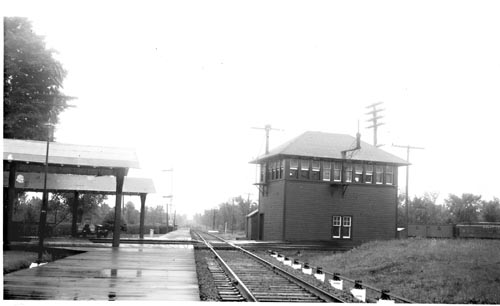 A
September 1948 view looking south along the Prescott subdivision.
The diamonds can be seen in the foreground
and some work equipment is standing on the south connecting track to
the
right. On the left are the two platform
awnings over the Winchester subdivision platforms. Canada Science
and Technology Museum – Matt-3838.
|
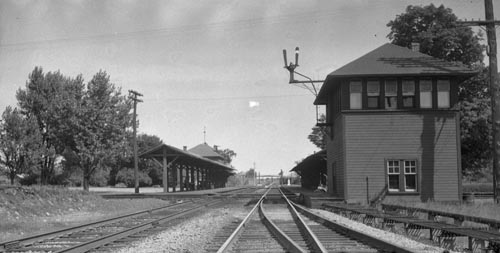 Taken
in September 1950, this view shows the tower and the
arrangement
of station buildings. Looking eastward
along the Winchester subdivision. Canada Science and Technology Museum
–
Matt-6546.
|
 Footnotes
[1] Much of the information for this section has been taken from Public Archives of Canada RG 46 Accession number 1992-92/066 Box 17 file 15499.5. Details of the final history of the interlocking were obtained by permission from Transport Canada file ASRE 3550-8-2-90. [2] Board of Railway Commissioners order 5070 of 22 July 1908. [3]
Board
of
Railway Commissioners order 5262 of 2 September 1908.
[4] Board of Railway Commissioners order 28117 of 24 February 1919. [5] Canadian Pacific Plan X-2-244-3 of 6 February 1919. [6] Board of Railway Commissioners order 28430 of 12 June 1919. [7] Diagram of Interlocking Plant and General Description of Signals at Bedell Crossing, CPR Chief Engineer's Office plan X-3-269, Montreal, 22 May 1919. [8] Board of Railway Commissioners order 48344 of 17 March 1932. [9] Board of Railway Commissioners order 55157 of 4 November 1937. [10] Board of Transport Commissioners order 61058 of 2 August 1941. [11] Board of Transport Commissioners order 93501 of 29 January 1958. [12] Board of Transport Commissioners order 124659 of 2 June 1967. [13] Letter from Canadian Pacific to the Canadian Transport Commission on 20 October 1967. [14] Canadian Transport Commission order R-10061 of 2 November 1970. |
![]()